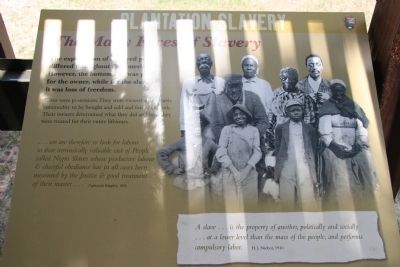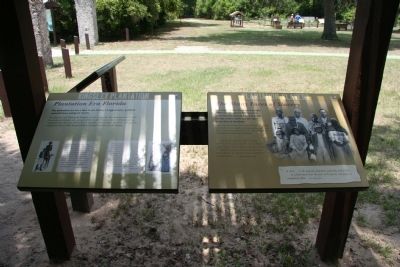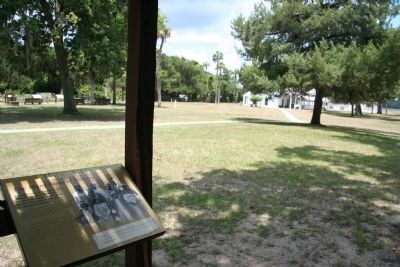Fort George Island near Jacksonville in Duval County, Florida — The American South (South Atlantic)
Plantation Slavery
The Many Faces of Slavery
Slaves were possessions. They were viewed as a valuable commodity to be bought and sold and forced to work. Their owners determined what they did and how they were treated for their lifetimes.
...we are therefore to look for labour to that intrinsically valuable cast of People called Negro Slaves whose productive labour & cheerful obediance has in all cases been measured by the Justice & good treatment of their master...
Zephaniah Kingsley, 1826
A slave...is the property of another, politically and socially...at a lower level than the mass of the people, and performs compulsory labor.
H.J. Niebor, 1910
Erected by The National Park Service.
Topics. This historical marker is listed in these topic lists: African Americans • Agriculture • Settlements & Settlers. A significant historical year for this entry is 1826.
Location. 30° 26.343′ N, 81° 26.245′ W. Marker is near Jacksonville, Florida, in Duval County. It is on Fort George Island. Marker is on Palmetto Avenue, 2.1 miles north of Fort George Road, on the left when traveling north. This historical marker is located in a national park. The historical marker is in a very remote area that is reached by traveling a considerable distance on an unpaved dirt road. To get there one must turn north, off of the Florida State Route 1A (Heckscher Road), onto Fort George Road, and then traveling about 0.6 miles to the intersection of Fort George Road and Palmetto Avenue, where you turn north on Palmetto Avenue and travel to the end of this road to reach the historical marker. The turn-off from state route 1A can be identified by the "Kingsley Plantation, Fort George Island Visitor Center" sign that is situated right at the turnoff point. Touch for map. Marker is in this post office area: Jacksonville FL 32226, United States of America. Touch for directions.
Other nearby markers. At least 8 other markers are within walking distance of this marker. Kingsley Plantation (here, next to this marker); a different marker also named Kingsley Plantation (here, next to this marker); a different marker also named Kingsley Plantation (a few steps from this marker); Plantation Crops (within shouting distance of this marker); Task System (within shouting distance of this marker); Slaves Cabins (within shouting distance of this marker); Looking Back (within shouting distance of this marker); a different marker also named Looking Back (within shouting distance of this marker). Touch for a list and map of all markers in Jacksonville.
Also see . . .
1. Kingsley Plantation. This is a link to information provided by the National Park Service. (Submitted on February 25, 2011, by Dale K. Benington of Toledo, Ohio.)
2. Kingsley Plantation. This is a link to information provided by Wikipedia, the free encyclopedia. (Submitted on February 25, 2011, by Dale K. Benington of Toledo, Ohio.)
Credits. This page was last revised on February 3, 2023. It was originally submitted on February 25, 2011, by Dale K. Benington of Toledo, Ohio. This page has been viewed 926 times since then and 20 times this year. Last updated on May 21, 2015, by Richard E. Miller of Oxon Hill, Maryland. Photos: 1, 2, 3. submitted on February 25, 2011, by Dale K. Benington of Toledo, Ohio. • Bill Pfingsten was the editor who published this page.


